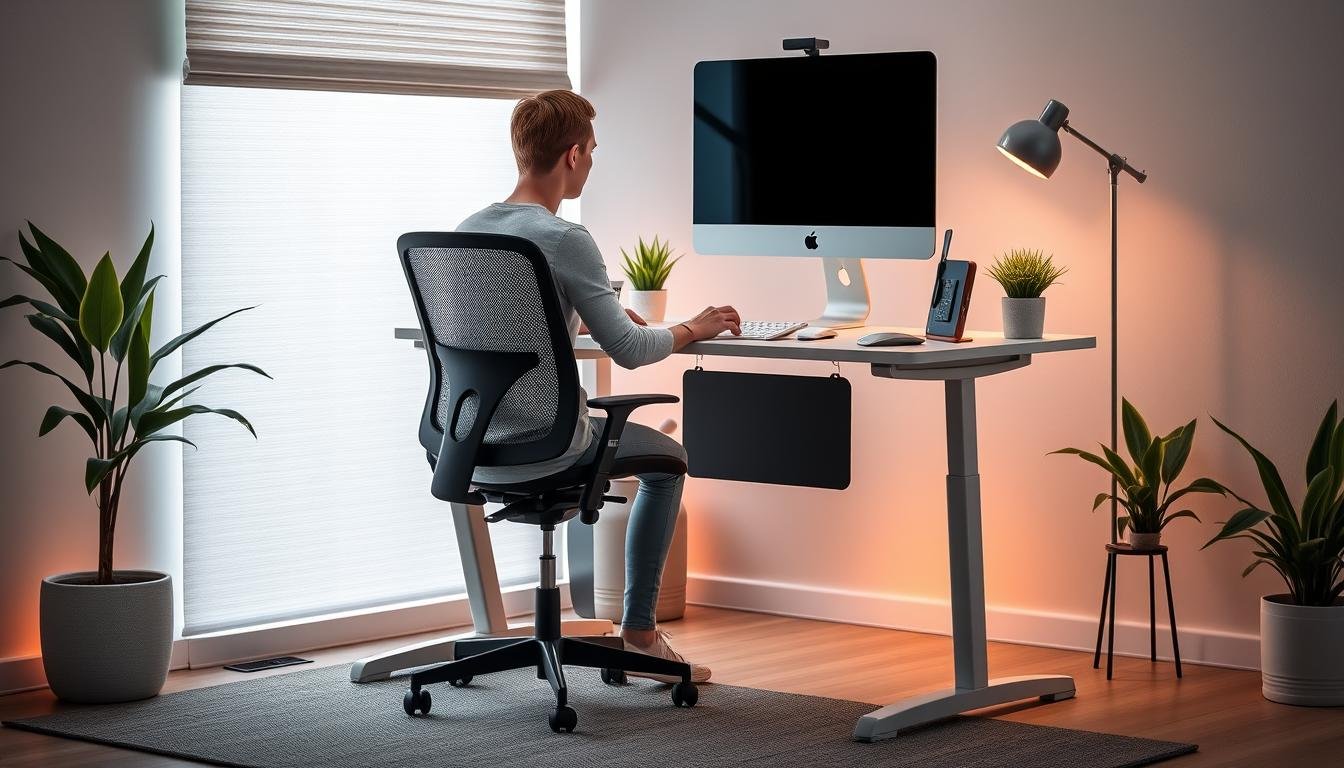Tech neck is a new problem caused by using devices too much. It causes neck pain and bad posture for people of all ages.
You can take steps to feel better and improve your posture. This guide will help you fix your tech neck and feel good again.
A human figure hunched over a smartphone, surrounded by a chaotic array of digital devices, with visible strain on the neck and shoulders, contrasting against a serene background depicting a healthy posture with gentle curves, soft colors, and balanced elements symbolizing relaxation and well-being.
We’ll show you how to deal with the causes of tech neck, and you’ll learn exercises and better ways to use your devices.
These tips will help ease your pain and prevent future problems. Your posture will improve, and you’ll feel much better overall.
Understanding Tech Neck: Causes and Symptoms
“Tech neck” is a common problem caused by overusing digital devices. It can lead to neck pain, headaches, and shoulder tension.
Poor posture is the leading cause of tech neck. Looking down at devices strains neck and upper back muscles.
This “text neck” position stresses the spine and muscles, which can cause pain and discomfort over time.
Tech devices can also cause eye strain and fatigue. They may even disrupt sleep patterns.
Our bodies don’t get proper rest when we focus on screens. This makes tech neck symptoms worse.
Untreated tech neck can lead to more serious problems. These include chronic neck pain and reduced motion range.
Some people may need help from a physical therapist or chiropractor. They can address the causes and provide proper treatment.
The Importance of Good Posture
Good posture is vital for our health and well-being. Poor posture, like hunching over devices, can harm our bodies.
This “tech neck” can cause neck pain and headaches. It may even lead to long-term spinal problems.
Good posture helps ease tech neck symptoms. It also improves breathing and reduces muscle strain.
Proper alignment can boost energy levels, too. Posture and health are closely linked.
The tech neck impact affects our daily activities. Constant device use strains neck and shoulder muscles.
This can cause discomfort and chronic pain. Being aware of good posture benefits can help.
By adjusting our posture, we can avoid these issues, leading to a healthier, more comfortable life.
Simple Exercises to Alleviate Tech Neck
Tech neck relief doesn’t have to be complicated. Try these easy neck exercises, shoulder stretches, and core activities.
Gently tilt your head to one side for 30 seconds. Repeat on the other side.
Roll your shoulders back and down in circles. This opens up the chest and eases upper back tightness.
Interlace fingers behind your back. Gently pull arms away to stretch shoulder fronts.
Core strength is key for good posture. Planks, crunches, and oblique twists build ab and back muscles.
Do these exercises daily. They can ease your neck and boost your posture.
Ergonomic Solutions for Your Workspace
An ergonomic workspace helps fight the tech neck. Optimize your desk setup to reduce neck and shoulder strain.
Your ergonomic desk setup should fit your needs. Adjust your chair and desk for comfort.
Set your monitor at eye level or slightly below. This keeps your neck in a neutral position.
Use a document holder next to your monitor. It prevents constant head turning between screen and papers.
A stylish ergonomic workspace featuring a modern adjustable standing desk, an ergonomic chair with lumbar support, a large computer monitor at eye level, a soft mouse pad and keyboard, plants for a touch of nature, and warm ambient lighting. The scene embodies minimalism and functionality, showcasing a clean, organized look that promotes healthy posture.
Choose a supportive, adjustable chair for your ergonomic workspace. Look for good lumbar support to maintain a neutral spine.
Adjust your chair to the proper elbow and thigh position. Keep elbows at 90 degrees when typing.
These ergonomic solutions promote good posture. They help prevent tech neck and improve your health.
Invest in workspace ergonomics for long-term well-being. Your body will thank you later.
Mindful Tech Usage Habits
In the digital age, our devices can easily distract us. Mindful tech use helps prevent and ease tech neck.
Healthy habits protect our neck and spine from prolonged device usage. They help us keep good posture.
The 20-20-20 rule is a simple yet effective strategy. Every 20 minutes, take a 20-second break.
Look at something 20 feet away during this break. This reduces eye strain and encourages better posture.
Set reasonable limits on your device usage. Limit your daily screen time and take regular breaks.
Stretch and move around to give your neck rest. Find device usage limits that fit your lifestyle.
These habits help fight tech neck risks. They also maintain a healthy posture.
Small changes can significantly improve your neck health. They boost your overall well-being, too.
Incorporating Breaks into Your Routine
Regular work breaks help fight the “tech neck” and boost productivity. Short breaks also reduce neck strain and improve circulation.
Try walking, stretching your neck, or practicing mindfulness meditation. These activities can make a big difference.
Set a timer for breaks every 60-90 minutes. Use this time to move and give your eyes a screen break.
Break activities can reduce neck strain and improve posture. They also help you focus better.
Taking breaks may seem odd, but they’re good for you. They can make you more productive and efficient.
Make an effort to step away from your desk. Your neck and overall well-being will benefit.
Yoga and Stretching for Tech Neck Relief
Tech neck is the discomfort caused by long hours using digital devices. Yoga and stretching can help ease tension in the neck and shoulders.
Start your day with simple neck stretches. Gently tilt your head side to side or roll it in circles.
Try yoga poses like Cat-Cow or Child’s Pose. These target the upper body and improve posture.
Downward-Facing Dog, Cobra, and Shoulder-Opening Pose are fantastic for tech neck. They strengthen your core and lengthen your spine.
A few minutes of yoga daily can improve neck health. Make these practices part of your routine for better posture.
Utilizing Technology to Combat Tech Neck
Tech is both the cause and solution for tech neck. Posture apps and wearable tech can help fight this modern problem.
Posture apps use sensors to spot lousy posture. They give real-time feedback to users through vibrations or alerts.
These reminders help users sit or stand straight. By raising awareness, users can form better habits and avoid tech neck.
Wearable tech for posture offers more advanced solutions. Devices like Upright Pro track spinal alignment and give feedback.
This constant monitoring helps train the body to stay upright. It works even during long periods of tech use.
Tech neck prevention tools can improve your spine health. Using these tools daily can make a big difference.
With technology, you can take charge of your posture. Say goodbye to the pains of tech neck.
Creating a Long-Term Prevention Strategy
Good posture and tech neck prevention need a long-term approach. Check your tech habits and find ways to improve them.
Assess your posture often. Adjust your workstation and take breaks to keep proper alignment.
Build healthy tech habits. Limit smartphone use and adjust screen brightness.
Use the 20-20-20 rule. Look away from the screen every 20 minutes.
Do stretches daily. This will support your neck and back muscles.
A good strategy can reduce tech neck risks. It can improve posture and overall well-being.
Preventing tech neck is ongoing. Stick to good habits for long-term benefits.
FAQ
What is tech neck, and how can I identify the symptoms?
Tech neck results from overusing electronic devices. It causes poor posture and neck strain.
Symptoms include neck pain, stiffness, headaches, and shoulder tension.
What are the leading causes of tech neck?
Tech neck is caused by long device use and poor posture. Looking down at screens strains the neck and upper back muscles.
When should I seek professional help for tech neck?
Seek help if tech neck symptoms persist or worsen. Consult a physical therapist or chiropractor for severe pain.
What are the benefits of maintaining good posture?
Good posture eases tech neck and improves spinal health. It boosts energy and enhances breathing.
What are some simple exercises I can do to alleviate tech neck?
Try neck stretches, shoulder rolls, and upper back exercises. These improve flexibility and reduce muscle tension.
How can I set up an ergonomic workspace to prevent tech neck?
Adjust your desk, chair, and monitor to the right height. For better posture, use a standing desk or adjustable monitor.
What mindful tech usage habits can I adopt to prevent tech neck?
Use the 20-20-20 rule: Take breaks every 20 minutes, set device time limits, and be aware of your posture.
How can I incorporate more breaks into my daily routine to combat tech neck?
Take short walks and stretch every 1-2 hours. To reduce neck strain, try brief mindfulness exercises.
What yoga and stretching techniques can I use to relieve my neck?
Do neck rolls, shoulder shrugs, and gentle backbends. Try chest-opening exercises to improve flexibility and posture.
How can technology help me prevent and manage tech neck?
Use posture-tracking apps and wearable devices for real-time feedback. These tools remind you to correct your position.
you may also read:The Ultimate Guide to Tubidy MP3 Download Songs

